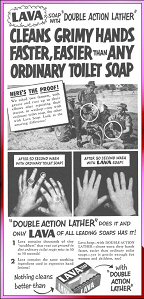P&G Soap Drab In Color…..
Great For Washing Hands
"L-A-V-A! L-A-V-A!"
Lincoln, Me. (DG)---
 Lava
Soap may not necessarily be the most glamorous bar soap ever
made. Its gray color may fit in better with the
color scheme of a prison than with kitchens and bathrooms in the typical
American home--- but when it comes to washing hands completely clean from
dirt and gunk, it was simply the best in the business. Lava
Soap may not necessarily be the most glamorous bar soap ever
made. Its gray color may fit in better with the
color scheme of a prison than with kitchens and bathrooms in the typical
American home--- but when it comes to washing hands completely clean from
dirt and gunk, it was simply the best in the business.
We have heard terms like Brass Knuckles, Knuckle Ball, and Knucklehead
(some people think the latter is my real name). During the
1930's, Lava introduced an adversary known as "Knuckle Grime."
It meant exactly as the name implied--- dirt and grime grounded into the knuckles. People who had this problem hid their hands in their pockets when they were
around other people. Lava easily cleaned away knuckle grime
from hands. The result was people could be expressive with their hands without
feeling ashamed (unless that expression was in bad taste).
The reason why Lava could do this could be linked to the product's
name--- and the volcano on the Lava box. Each regulation gray
Lava soap bar contained powdery pumice--- the same stuff that
comes out when a volcano belches. The pumice combined with a gentle soap cleaned
hands thoroughly and fast--- although the timing it took to do this varied.
In 1941, a commercial for Lava was heard at the closing of a
VIC & SADE broadcast. The subject of the commercial was an invitation
by Procter & Gamble to the radio listeners to write a letter
to the company on their experiences of washing their hands with Lava.
In finishing off the commercial, the announcer said Lava cleaned
extra dirty hands in only 20 seconds. The
following year, it took from 20-50 seconds--- and the year after that, it
was from 30-50 seconds. The
following year, it took from 20-50 seconds--- and the year after that, it
was from 30-50 seconds. No,
Lava wasn't slowing down with age, because it would take from
30-50 seconds to wash the hands clean for the remainder of radio's golden
age. No,
Lava wasn't slowing down with age, because it would take from
30-50 seconds to wash the hands clean for the remainder of radio's golden
age.
During the war years, Lava was the soap everyone on the home
front should use. Of course, good health was essential for war workers, mothers,
housewives, and children. A grim reality was that hands came in contact with
various surfaces that not only had dirt, grime, and gunk, but also germs.
Since it was imperative to maintain good health during this time, Lava
came in handy for washing hands completely clean.
 Lava
will be remembered on radio for its sponsorship of the popular CBS
anthology THE FBI IN PEACE & WAR. On this program, the radio
listeners were introduced to Lava's new "jingle." Accompanied
with a bass drum, a husky sounding voice sang out "L-A-V-A! L-A-V-A!"
It's doubtful this little ditty would ever make the top songs of YOUR
HIT PARADE, but then again, Lava didn't sponsor that
program, either. It was, however, a memorable jingle. Lava
will be remembered on radio for its sponsorship of the popular CBS
anthology THE FBI IN PEACE & WAR. On this program, the radio
listeners were introduced to Lava's new "jingle." Accompanied
with a bass drum, a husky sounding voice sang out "L-A-V-A! L-A-V-A!"
It's doubtful this little ditty would ever make the top songs of YOUR
HIT PARADE, but then again, Lava didn't sponsor that
program, either. It was, however, a memorable jingle.
On a 1953 broadcast of THE FBI IN PEACE & WAR, Lava
was put to the test against another brand of soap in the "Lava Wash-up
Test." The test consisted of 2 men, 2 sinks with running water,
Lava, and the infamous "other soap." One man washed his hands
with Lava, and the other man washed his with the other soap.
While the 2 men were washing their hands, the announcer exclaimed, "Wow!
Look at Lava get that dirt!" This comment was more than interesting
because it was a radio commercial. The general rule was when
the radio listeners could see with their eyes what they were hearing, it was
known as television (pardon me for using the "T" word in a radio article)!
Since the planet earth is populated with people with different personalities,
there might a remote possibility some radio listeners were washing their own
hands with Lava while listening to the commercial. Personally,
I can come to 2 different conclusions concerning the announcer's comment.
1.) It was a radio boner, and 2.) The radio commercial was the
audio from a television commercial (once again, excuse me for using that word).
If you're wondering, the Lava Wash-up Test went according to
Hoyle. The man who used Lava said his hands were clean, while
the man who used the other soap said there was still some dirt on his hands
and on the towel he used to dry his hands. Once again, Lava
prevailed as the best hand soap.
Although Lava was made in a drab gray color, it did have some
colorful advertising during radio's golden age--- and it also kept the hands
of men, women, and children clean.
|